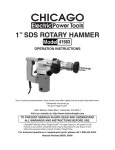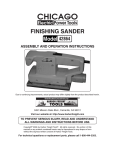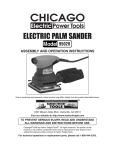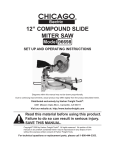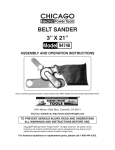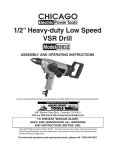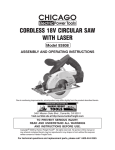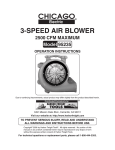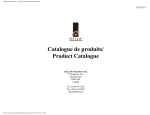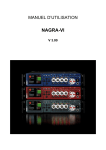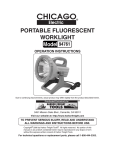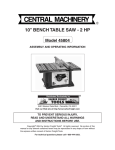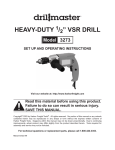Download Harbor Freight Tools 41983 User's Manual
Transcript
1” SDS ROTARY HAMMER 41983 Operation Instructions Due to continuing improvements, actual product may differ slightly from the product described herein. ® 3491 Mission Oaks Blvd., Camarillo, CA 93011 Visit our website at: http://www.harborfreight.com To prevent serious injury, read and understand all warnings and instructions before use. Copyright© 2000 by Harbor Freight Tools®. All rights reserved. No portion of this manual or any artwork contained herein may be reproduced in any shape or form without the express written consent of Harbor Freight Tools. For technical questions or replacement parts, please call 1-800-444-3353. Manual Revised 08/05; 09/06 Specifications Motor 110 V~, 60 Hz, 620 W, n0 750/min Capacity 1” Chuck Type SDS Rotation Reversible Cord 7’ UL Listed with 2-Pole Polarized Plug BPM 2920 Weight 10.5 lb. Also Includes Spanner, (4) SDS Drill Bits (10,12,14 and 22 mm), 4 Point Chisel, Depth Gauge Rod, Grease, and Carbon Brush Set E194601 Save This Manual You will need this manual for the safety warnings and precautions, assembly, operating, inspection, maintenance and cleaning procedures, parts list and assembly diagram. Keep your invoice with this manual. Write the invoice number on the inside of the front cover. Write the product’s serial number in the back of the manual near the assembly diagram, or write month and year of purchase if product has no number. Keep this manual and invoice in a safe and dry place for future reference. GENERAL SAFETY RULES WARNING! READ AND UNDERSTAND ALL INSTRUCTIONS Failure to follow all instructions listed below may result in electric shock, fire, and/or serious injury. SAVE THESE INSTRUCTIONS Work Area 1. Keep your work area clean and well lit. Cluttered benches and dark areas invite accidents. 2. Do not operate power tools in explosive atmospheres, such as in the presence of flammable liquids, gases, or dust. Power tools create sparks which may ignite the dust or fumes. 3. Keep bystanders, children, and visitors away while operating a power tool. Distractions can cause you to lose control. Protect others in the work area from debris such as chips and sparks. Provide barriers or shields as needed. SKU 41983 For technical questions, please call 1-800-444-3353. Page Electrical Safety 1. Grounded tools must be plugged into an outlet properly installed and grounded in accordance with all codes and ordinances. Never remove the grounding prong or modify the plug in any way. Do not use any adapter plugs. Check with a qualified electrician if you are in doubt as to whether the outlet is properly grounded. If the tools should electrically malfunction or break down, grounding provides a low resistance path to carry electricity away from the user. 2. Double insulated tools are equipped with a polarized plug (one blade is wider than the other). This plug will fit in a polarized outlet only one way. If the plug does not fit fully in the outlet, reverse the plug. If it still does not fit, contact a qualified electrician to install a polarized outlet. Do not change the plug in any way. Double insulation eliminates the need for the three wire grounded power cord and grounded power supply system. 3. Avoid body contact with grounded surfaces such as pipes, radiators, ranges, and refrigerators. There is an increased risk of electric shock if your body is grounded. 4. Do not expose power tools to rain or wet conditions. Water entering a power tool will increase the risk of electric shock. 5. Do not abuse the Power Cord. Never use the Power Cord to carry the tools or pull the Plug from an outlet. Keep the Power Cord away from heat, oil, sharp edges, or moving parts. Replace damaged Power Cords immediately. Damaged Power Cords increase the risk of electric shock. 6. When operating a power tool outside, use an outdoor extension cord marked “W-A” or “W”. These extension cords are rated for outdoor use, and reduce the risk of electric shock. Personal Safety 1. Stay alert. Watch what you are doing, and use common sense when operating a power tool. Do not use a power tool while tired or under the influence of drugs, alcohol, or medication. A moment of inattention while operating power tools may result in serious personal injury. 2. Dress properly. Do not wear loose clothing or jewelry. Contain long hair. Keep your hair, clothing, and gloves away from moving parts. Loose clothes, jewelry, or long hair can be caught in moving parts. 3. Avoid accidental starting. Be sure the Power Switch is off before plugging in. Carrying power tools with your finger on the Power Switch, or plugging in power tools with the Power Switch on, invites accidents. 4. Remove adjusting keys or wrenches before turning the power tool on. A wrench or a key that is left attached to a rotating part of the power tool may result in personal injury. 5. Do not overreach. Keep proper footing and balance at all times. Proper footing and balance enables better control of the power tool in unexpected situations. SKU 41983 For technical questions, please call 1-800-444-3353. Page 6. Use safety equipment. Always wear eye protection. Dust mask, nonskid safety shoes, hard hat, or hearing protection must be used for appropriate conditions. Always wear ANSIapproved safety goggles and a dust mask/respirator when using or performing maintenance on this tool. Tool Use And Care 1. Use clamps (not included) or other practical ways to secure and support the workpiece to a stable platform. Holding the work by hand or against your body is unstable and may lead to loss of control. 2. Do not force the tool. Use the correct tool for your application. The correct tool will do the job better and safer at the rate for which it is designed. Do not force the tool and do not use the tool for a purpose for which it is not intended. 3. Do not use the power tool if the Power Switch does not turn it on or off. Any tool that cannot be controlled with the Power Switch is dangerous and must be replaced. 4. Disconnect the Power Cord Plug from the power source before making any adjustments, changing accessories, or storing the tool. Such preventive safety measures reduce the risk of starting the tool accidentally. Always unplug the tool from its electrical outlet before performing any inspection, maintenance, or cleaning procedures. 5. Store idle tools out of reach of children and other untrained persons. Tools are dangerous in the hands of untrained users. 6. Maintain tools with care. Keep cutting tools sharp and clean. Properly maintained tools with a sharp cutting edge are less likely to bind and are easier to control. Do not use a damaged tool. Tag damaged tools “Do not use” until repaired. 7. Check for misalignment or binding of moving parts, breakage of parts, and any other condition that may affect the tool’s operation. If damaged, have the tool serviced before using. Many accidents are caused by poorly maintained tools. 8. Use only accessories that are recommended by the manufacturer for your model. Accessories that may be suitable for one tool may become hazardous when used on another tool. Service 1. Tool service must be performed only by qualified repair personnel. Service or maintenance performed by unqualified personnel could result in a risk of injury. 2. When servicing a tool, use only identical replacement parts. Follow instructions in the “Inspection, Maintenance, And Cleaning” section of this manual. Use of unauthorized parts or failure to follow maintenance instructions may create a risk of electric shock or injury. SKU 41983 For technical questions, please call 1-800-444-3353. Page SPECIFIC SAFETY RULES 1. Hold tools by insulated gripping surfaces when performing an operation where the cutting tool may contact hidden wiring or its own cord. Contact with a “live” wire will make exposed metal parts of the tool “live” and shock the operator. 2. Wear ear protectors when using the tool for extended periods. Prolonged exposure to high intensity noise can cause hearing loss. 3. Maintain labels and nameplates on the tool. These carry important information. If unreadable or missing, contact Harbor Freight Tools for a replacement. 4. Maintain a safe working environment. Make sure there is adequate surrounding workspace. Do not use this product in a damp or wet location. 5. When using a handheld power tool, always maintain a firm grip on the tool with both hands to resist starting torque. Always use the Auxiliary Handle to control kickback and torque reactions. 6. Do not operate the Rotary Hammer if any of the following problems occur: Hammer is too hot, insulation is torn, frayed or missing or if excessive sparking occurs. 7. Move the Switching Knob (22) and Main Handle (91) only when the motor is stopped. Attempting to move either one while the motor is engaged will result in abrupt bit rotation, and can cause serious personal injury and/or property damage. 8. Do not allow the bit to stop while in the hole. Remove the bit while it is still rotating. If the bit stops while in the hole, do not restart the Rotary Hammer. Remove the bit from the Hammer and then remove it from the material being worked on. 9. Avoid unintentional starting. Make sure you are prepared to begin work before turning on the tool. 10. Always keep the extension cord away from moving parts on the tool. 11. WARNING! People with pacemakers should consult their physician(s) before using this product. Electromagnetic fields in close proximity to a heart pacemaker could cause interference to or failure of the pacemaker. In addition, people with pacemakers should adhere to the following: • Avoid operating power tools alone. • Don’t use a power tool with the power switch locked on. • If powered via a power cord be certain that the tool is properly grounded. A ground fault interrupt (GFCI) system is also a good precaution. This inexpensive device is a good safety measure because it prevents a sustained electrical shock. • Properly maintain and inspect all tools before use to avoid electrical shock. 12. Never lay the tool down until it has come to a complete stop. Moving parts can grab the surface and pull the tool out of your control. 13. Never leave the tool unattended when it is plugged into an electrical outlet. Turn off the tool, and unplug it from its electrical outlet before leaving. SKU 41983 For technical questions, please call 1-800-444-3353. Page 14. WARNING! Some dust created by power sanding, sawing, grinding, drilling, and other construction activities, contain chemicals known (to the State of California) to cause cancer, birth defects or other reproductive harm. Some examples of these chemicals are: • Lead from lead-based paints. • Crystalline silica from bricks and cement or other masonry products. • Arsenic and chromium from chemically treated lumber. Your risk from these exposures varies, depending on how often you do this type of work. To reduce your exposure to these chemicals: work in a well-ventilated area, and work with approved safety equipment, such as those dust masks that are specially designed to filter out microscopic particles. (California Health & Safety Code § 25249.5, et seq.) GROUNDING WARNING! Improperly connecting the grounding wire can result in the risk of electric shock. Check with a qualified electrician if you are in doubt as to whether the outlet is properly grounded. Do not modify the power cord plug provided with the tool. Never remove the grounding prong from the plug. Do not use the tool if the power cord or plug is damaged. If damaged, have it repaired by a service facility before use. If the plug will not fit the outlet, have a proper outlet installed by a qualified electrician. Grounded Tools: Tools With Three Prong Plugs 1. Tools marked with “Grounding Required” have a three wire cord and three prong grounding plug. The plug must be connected to a properly grounded outlet. If the tool should electrically malfunction or break down, grounding provides a low resistance path to carry electricity away from the user, reducing the risk of electric shock. (See Figure A.) 2. The grounding prong in the plug is connected through the green wire inside the cord to the grounding system in the tool. The green wire in the cord must be the only wire connected to the tool’s grounding system and must never be attached to an electrically “live” terminal. (See Figure A.) SKU 41983 For technical questions, please call 1-800-444-3353. Page 3. Your tool must be plugged into an appropriate outlet, properly installed and grounded in accordance with all codes and ordinances. The plug and outlet should look like those in the following illustration. (See Figure A.) FIGURE A FIGURE B Double Insulated Tools: Tools With Two Prong Plugs Note: This tool has a two-prong plug. 1. Tools marked “Double Insulated” do not require grounding. They have a special double insulation system which satisfies OSHA requirements and complies with the applicable standards of Underwriters Laboratories, Inc., the Canadian Standard Association, and the National Electrical Code. (See Figure B.) 2. Double insulated tools may be used in either of the 120 volt outlets shown in the preceding illustration. (See Figure B.) Extension Cords 1. Grounded tools require a three wire extension cord. Double Insulated tools can use either a two or three wire extension cord. 2. As the distance from the supply outlet increases, you must use a heavier gauge extension cord. Using extension cords with inadequately sized wire causes a serious drop in voltage, resulting in loss of power and possible tool damage. (See Figure C, next page.) 3. The smaller the gauge number of the wire, the greater the capacity of the cord. For example, a 14 gauge cord can carry a higher current than a 16 gauge cord. (See Figure C.) 4. When using more than one extension cord to make up the total length, make sure each cord contains at least the minimum wire size required. (See Figure C.) 5. If you are using one extension cord for more than one tool, add the nameplate amperes and use the sum to determine the required minimum cord size. (See Figure C.) 6. If you are using an extension cord outdoors, make sure it is marked with the suffix “W-A” (“W” in Canada) to indicate it is acceptable for outdoor use. SKU 41983 For technical questions, please call 1-800-444-3353. Page 7. Make sure your extension cord is properly wired and in good electrical condition. Always replace a damaged extension cord or have it repaired by a qualified electrician before using it. 8. Protect your extension cords from sharp objects, excessive heat, and damp or wet areas. RECOMMENDED MINIMUM WIRE GAUGE FOR EXTENSION CORDS* (120 or 240 VOLT) NAMEPLATE AMPERES EXTENSION CORD LENGTH (at full load) 25 Feet 50 Feet 75 Feet 100 Feet 150 Feet 0 – 2.0 18 18 18 18 16 2.1 – 3.4 18 18 18 16 14 3.5 – 5.0 18 18 16 14 12 5.1 – 7.0 18 16 14 12 12 7.1 – 12.0 18 14 12 10 - 12.1 – 16.0 14 12 10 - - 16.1 – 20.0 12 10 - - - FIGURE C * Based on limiting the line voltage drop to five volts at 150% of the rated amperes. Symbology Double Insulated Canadian Standards Association Underwriters Laboratories, Inc. V~ A Volts Alternating Current Amperes n0 xxxx/min. No Load Revolutions per Minute (RPM) Unpacking When unpacking, check to make sure that the item is intact and undamaged. If any parts are missing or broken, please call Harbor Freight Tools at the number shown on the cover of this manual as soon as possible. SKU 41983 For technical questions, please call 1-800-444-3353. Page Setup and Settings The 1” Rotary hammer is designed to be used in the following applications: • For drilling stone, concrete, and other hard and brittle materials. • For chiseling. Switching Knob (22) Drill Bit Switch (96) Dust Cover (104) Main Handle (91) Spring (41) Depth Gauge (106) Auxiliary Handle (107) Carbon Brush (82) Figure 1 - Operating Your Rotary Hammer See Figure 1 above to become familiar with the various features of the Rotary Hammer. A complete part number listing is shown on page 9. The complete Assembly Diagram is located on page 10. Inserting and Removing Drill Bits Warning: Always wear gloves to provide protection when inserting and removing drill bits. Drill bits become very hot in use. Do not remove drill bits until the bit has completely cooled off. Do not strike stuck bits with a hammer as metal chips may fly off. Always remove the electrical plug from the electrical outlet when inserting and removing bits and chisels. 1. Your Rotary Hammer comes with a Dust Cover (104). Slide the Dust Cover over the Front Cover (39). 2. Add a coating of grease or machine oil to the drill or bit shank. 3. Pull back on the Spring (41) - see Figure 1, while simultaneously inserting and turning the drill bit until it slides all the way in. Release the Spring (41) so that it returns to its original position. You should not be able to move the bit without pulling back on the spring again. Make certain the bit does not move, this will ensure that it is properly installed. 4. To remove the bit, pull back on the Spring (41) and pull out the bit. For optimal performance, always keep bit and chisels properly sharpened. SKU 41983 For technical questions, please call 1-800-444-3353. Page Note: When drilling a hole larger than 1-1/4” diameter, always use a drill bit with 4 cutting edges. Adjusting the Auxiliary Handle The Auxiliary Handle (107) can be placed into a variety of different positions. To rotate the Auxiliary Handle (107), turn the Auxiliary Handle (107) counterclockwise to loosen the band and Foursquare Bolt (111). Once loosened, turn the Auxiliary Handle to the position desired. Turn the Handle clockwise to tighten into place. Using the Depth Gauge The Depth Gauge (106) can only be used if the Auxiliary Handle (107) is positioned on either side or the top of the Rotary Hammer. The body of the Hammer will interfere with the Depth Gauge if the handle is in the bottom position. 1. Loosen the Auxiliary Handle (107) by twisting the Handle counterclockwise. 2. Once the Auxiliary Handle (107) is sufficiently loose, pull back on the Handle Holder (108) until the hole in the Handle Holder (108) is fully open. Main Handle-Right Side Position Main Handle-Left Side Position Switching Knob Figure 2 - Changing Settings 3. Slide the Depth Gauge (106) in to the desired length. The tip of the Depth Gauge on the front of the Hammer should be the desired depth of the hole to be drilled. The depth is from the tip of the bit to the tip of the Depth Gauge. For example for a 2” hole, measure 2” back from the tip of the bit. Position the front tip of the Depth Gauge at that spot (See Figure 1). 4. After the Depth Gauge (106) is positioned in the desired position, slide the Handle Holder (108) up and twist the Auxiliary Handle clockwise until tight. The Depth Gauge should be securely in position, and should not move. Changing the Settings • Your Rotary Hammer has both a Switching Knob (22) and a Main Handle (91) which must be adjusted before drilling, hammer drilling, or chiselling - see Figure 2. SKU 41983 For technical questions, please call 1-800-444-3353. Page 10 Warning: Move the Switching Knob and Main Handle only when the motor is stopped. Attempting to move either the Switching Knob or Handle while the motor is engaged will result in abrupt bit rotation and can cause serious personal injury and/or property damage. Warning: When moving the Switching Knob and Handle, make sure both actively click into the desired position. If not actively engaged, the Knob or Handle could slip out of position, resulting in unexpected tool performance. • The front Switching Knob (22) has on one side- a symbol of a Hammer and a Drill. On the other side is a symbol of just a Hammer. The Main Handle (91) can be pointed either right or left. There are symbols for a Hammer and Drill on the left side and a symbol for a Drill only on the right side. • To drill only, set the Switching Knob (22) so that the picture of the Hammer and Drill are facing forward. Turn the Main Handle (91) so that it points to the right at the Drill symbol (See Figure 2). • To Hammer Drill, set the Switching Knob (22) so that the Hammer and Drill are facing forward. Turn the Main Handle (91) so that it points to the left at the Hammer and Drill symbol. • To Chisel, set the Switching Knob (22) so that the picture of the Hammer only points forward. Turn the Main Handle (91) so that it points left to the Hammer and Drill symbol. NOTE: Break Point (Bull) Bits and cold chisels are to be used when the Selector Switch is in the hammering position only. Using these bits/chisels with the Selector Switch in the hammer/drill position will result in unexpected tool performance. Operation 1. Before plugging in the electrical cord, insert the desired bit and adjust the Auxiliary Handle and Depth Gauge to the desired positions (See earlier sections). 2. While keeping your finger off the “ON” trigger Switch (96), plug in the electrical cord. 3. When ready to use the Rotary Hammer, first depress the “ON” trigger Switch (96) and allow the unit to run without load for approximately one minute. This allows parts to become properly lubricated. Check to see if the operating tool sounds normal. Once the tool has been warmed up, it is ready for use. 4. To turn off the Rotary Hammer, release the trigger Switch (96). SKU 41983 For technical questions, please call 1-800-444-3353. Page 11 INSPECTION, MAINTENANCE, AND CLEANING 1. WARNING! Make sure the Power Switch of the tool is in its “OFF” position and that the tool is unplugged from its electrical outlet before performing any inspection, maintenance, or cleaning procedures. 2. BEFORE EACH USE, inspect the general condition of the tool. Check for loose screws, misalignment or binding of moving parts, cracked or broken parts, damaged electrical wiring, and any other condition that may affect its safe operation. If abnormal noise or vibration occurs, have the problem corrected before further use. Do not use damaged equipment. 3. CLEANING: Regularly clean the work surface with a dry brush or clean cloth. Keep moving parts lightly greased. Always keep the Motor and vent areas free of dust and debris. 4. Lubrication: Use the enclosed spanner wrench to unscrew the Seal Cap (18) located on top of the housing. Add the enclosed grease and replace and tighten the Seal Cap. 5. Changing the Carbon Brushes: a. Using a small standard screwdriver, remove the Brush Covers (81). When you remove the Brush Caps, the Carbon Brush Holder (83) may spring out. Do not lose the Carbon Brushes. If the Brush Holder does not spring out, gently remove it by using the tip of your screwdriver. Examine the surface of each brush. The surface should be smooth and clean. If scratch marks appear, or if the brush is broken, replace the brush immediately with an approved replacement brush from Harbor Freight Tools. b. If the brush is not damaged but is only dirty, you may clean it off with a pencil eraser. Gently rub with the eraser until the dirt has been removed. Remove any eraser dust which may have accumulated during cleaning. c. Re-install each Carbon Brush (82) by inserting it back into the Brush Holder (83). Screw the Brush Cover (81) back into the Brush Holder and tighten. Maintenance Type Inspect tool for damage Clean outside and lubricate exposed moving parts Maintenance Chart Before After After Every 50 Use Use Hours of Use After Every 100 Hours of Use X X X Lubricate* Replace Carbon Brushes X *The Rotary Hammer is pre-greased from the factory. Lubrication is only needed starting after approximately 50 working hours. SKU 41983 For technical questions, please call 1-800-444-3353. Page 12 Troubleshooting Problem Possible Causes Disrupted power supply. Poor contact at the switch. Armature or field coil burnt. Breakage of the Stator coil. Carbon Brushes worn out. Probable Solutions Motor does not rotate switch on power supply. 1. 2. 3. 4. 5. 1. 2. 3. 4. 5. Check power supply. Repair switch. Change coil. Replace Stator Coil. Replace Carbon Brushes. Abnormal noise from motor; does not rotate or rotates slowly. Overload of motor caused by excessive drilling depth or pressure. Reduce drilling depth or pressure. Decrease force. Partial short circuit Partial short circuit or open circuit at Armature. Repair or change Armature. Main voltage too low Main power voltage too low. Adjust main power voltage. Gearbox becomes too 1. Overload, dull bit. hot. 2. Damp coils. 3. Incorrect fitting. 4. Decrease in voltage. 1. 2. 3. 4. Sparking 1. Repair Armature. 2. Inspect and clean Armature. 1. Short circuit or break at Armature. 2. Surface of Armature not smooth and clean. Reduce load, sharpen bit. Dry coils. Repair or change armature. Adjust voltage. Warranty SKU 41983 For technical questions, please call 1-800-444-3353. Page 13 PARTS LIST Part Description Q’ty Part Description Q’ty 1 O-ring 1 39 Front Cover 1 2 Steel Ball 3 40 O-ring 1 3 Cylinder 1 41 Spring 1 4 Feather Key 2 42 Steel Column 2 5 Piston 1 43 Retainer Sleeve 1 6 O-ring 1 44 O-ring 2 7 Spring Holder 1 45 O-ring 2 8 Spring 1 46 Second Hammer 1 9 Clutch 1 47 Spring 1 10 Third Gear 1 48 Name Plate 1 11 O-ring 1 49 Oil Sealing Ring 1 12 Piston 1 50 Gear Balling 1 13 Connecting Shaft 1 51 Distance Ring 1 14 Needle Bearing 1 52 Bearing 1 15 O-ring 1 53 Spacer 1 16 O-ring 1 54 Washer 2 17 Marking Plate 1 55 Slip Plate 2 18 Oil-Sealing 1 56 No. 2 Gear 1 19 Gear Housing 1 57 Spring Washer 1 20 Name Plate 1 58 Special Nut 1 21 Screw M 4 x 8 1 59 Bearing 1 22 Switching Knob 1 60 Crank Shaft 1 23 Spring 1 61 Steel Ball 3 24 Steel Ball 1 62 Bearing 1 25 Fixing Board 1 63 Washer 1 26 O-ring 1 64 Bearing Cover 1 27 Half-Circle Block 1 65 Screw M5 X 60 2 28 Screw M 3 X 8 2 66 No. 1 Gear 1 29 Draw Shaft 1 67 Washer 1 30 Screw M5 x 25 4 68 Spring 1 31 Spring 4 69 Clutch Shaft 1 32 Cylinder Case 1 70 Center Cover 1 33 Cylinder Cap 1 71 Bearing 1 34 Oil Seal 1 72 Armature 1 35 Washer 1 73 Fan Guide 1 36 Bearing 1 74 Field Screw 2 37 Distance Ring 1 75 Washer 2 38 Distance Cover 1 76 Inductance 2 SKU 41983 For technical questions, please call 1-800-444-3353. Page 14 Parts List (continued) Part Description Q’ty Part Description Q’ty 77 Bearing 1 95 Capacitor 1 78 Housing 1 96 Switch 1 79 Washer 4 97 Cord Pressing Board 1 80 Screw M5 x 50 4 98 Self Tapping Screw 4 X 16 2 81 Brush Cover 2 99 Board 1 82 Carbon Brush 2 100 Handle Pad 1 83 Brush Holder 2 101 Right Handle Cover 1 84 Tapping Screw $ x 16 2 102 Self Tapping Screw 5 X 25 2 85 Back Cover 1 103 Screw M 5 X 25 2 86 Fixed Screw M5 X 6 2 104 Dust cover 1 87 Self Tapping Screw M4 X 23 3 105 Blow Box 1 88 Needle Bearing 1 106 Depth Gauge 1 89 Spring Holder 1 107 Auxiliary Handle 1 90 O-ring 1 108 Handle Holder 1 91 Main Handle 1 109 Handle Shaft 1 92 Left Handle Cover 1 110 Pressing Board 1 93 Insulating Sleeve 4 111 Foursquare Bolt 1 94 Switch Cover 1 PLEASE READ THE FOLLOWING CAREFULLY The manufacturer and/or distributor has provided the parts list and assembly diagram in this manual as a reference tool only. Neither the manufacturer or distributor makes any representation or warranty of any kind to the buyer that he or she is qualified to make any repairs to the product, or that he or she is qualified to replace any parts of the product. In fact, the manufacturer and/or distributor expressly states that all repairs and parts replacements should be undertaken by certified and licensed technicians, and not by the buyer. The buyer assumes all risk and liability arising out of his or her repairs to the original product or replacement parts thereto, or arising out of his or her installation of replacement parts thereto. SKU 41983 For technical questions, please call 1-800-444-3353. Page 15 ASSEMBLY DIAGRAM Record Product’s Serial Number Here: Note: If product has no serial number, record month and year of purchase instead. Note: Some parts are listed and shown for illustration purposes only, and are not available individually as replacement parts. SKU 41983 For technical questions, please call 1-800-444-3353. Page 16 1 ” SDS MARTEAU ROTATIF 41983 LES INSTRUCTIONS D’OPÉRATION IMPORTANT! Cette édition de langue française est une traduction du manuel anglais original accompagnant ce produit. Si une partie du manuel anglais original est inconsistante avec cette traduction, le manuel anglais original gouvernera. En raison des améliorations continuantes, le produit réel peut différer légèrement du produit décrit ici. ® 3491 Mission Oaks Blvd., Camarillo, CA 93011 Visitez notre site Internet à http://www.harborfreight.com Pour éviter la blessure sérieuse, lisez et comprenez tous les avertissements et les instructions avant l’utilisation. Le Copyright© 2000 par le Harbor Freight Tools®. Tous droits réservés. Aucune portion de ce manuel ou de n’importe quel travail d’art contenu ici ne peut être reproduite dans aucune forme ou forme sans le consentement écrit explicite de Harbor Freight Tools. Pour les questions techniques et les pièces détachées, appelez-vous s’il vous plaît 1-800-444-3353. Caractéristiques Moteur 110 V~, 60 Hz, 620 W, no 750/min Capacité 1” Type de Mandrin SDS Rotation Reversible Cordon 7’ UL Listed avec Fiche polarisée à 2-Pole BPM 2920 Poids 10.5 lb. Clé (4) SDS Forets (10, 12, 14, et 22 mm), 4 Point Ciseau, Jauge de Profondeur, Graisse, et Les deux Balais de Carbone Aussi inclus GARDEZ CE GUIDE Gardez ce guide pour les conseils de sécurités et précautions, assemblage, instructions d’utilisation, inspection, entretien et nettoyage, la liste des pièces et le schéma du produit. Gardez votre facture avec ce guide. Inscrivez le numéro à l’intérieur de la couverture. Gardez ce guide et facture dans un endroit sécuritaire et sec pour pouvoir le consulter à l’avenir. REGLES DE SECURITE Avertissement! Lisez et assurez-vous de bien comprendre toutes les instructions. Le non -respect des instructions ci -après peut entrainer un risque de choc electrique d’incendie et/ou de blessures graves. Gardez ces instructions ESPACE DE TRAVAIL 1. Assurez-vous que l’espace de travail est propre et bien éclairé. Un établi encombré ou un endroit sombre est propice aux accidents. 2. N’utilisez pas un outil électrique dans un environnement aux propriétés explosives, comme en présence de poussière, de liquides ou de gaz inflammables. Les outils électriques produisent des étincelles qui peuvent enflammer les poussières ou les vapeurs. 3. Gardez les spectateurs, les enfants et les visiteurs à l’écart pendant que vous utilisez l’outil. Une distraction pourrait vous faire perdre la maîtrise de l’outil. Protégez des gens dans l’espace de travail de débris. Si nécessaire, construisez des barrières. SKU 41983 Pour les questions techniques, appelez-vous s’il vous plaît 1-800-444-3353. Page SECURITE ELECTRIQUE 1. Les outils mis à la terre doivent être branchés dans une prise de courant correctement installée et mise à la terre conformément à tous les codes et règlements pertinents. Ne modifiez jamais la fiche de quelque façon que ce soit, par exemple en enlevant la broche de mise à la terre. N’utilisez pas d’adaptateur de fiche. Si vous n’êtes pas certain que la prise de courant est correctement mise à la terre, adressez-vous à un électricien qualifié. En cas de défaillance ou de défectuosité électrique de l’outil une mise à la terre offre un trajet de faible résistance à l’électricité qui autrement risquerait de traverser l’utilisateur. 2. Les outil à double isolation sont munis d’une fiche polarisée (une lame est plus large que l’autre). Cette fiche s’enfonce d’une seule façon dans une prise de courant polarisée. Si la fiche ne s’insère pas à fond dans la prise de courant, inversez-la. Sinon, communiquez avec un électricien qualifié pour installer une prise de courant polarisée. Ne modifiez jamais la fiche. La double isolation élimine le besoin d’utiliser un cordon d’alimentation à trois broches avec fil de mise à la terre et un circuit d’alimentation mis à la terre. 3. Évitez tout contact du corps avec les surfaces reliées à la terre telles que tuyaux, radiateurs, cuisinières et réfrigérateurs. Le risque de choc électrique est accru lorsque le corps est mis à la terre. 4. N’exposez pas les outils électriques à la pluie ni à l’humidité. Toute infiltration d’eau dans l’outil augmente les risques de choc électrique. 5. Évitez l’emploi abusif du cordon. N’utilisez jamais le cordon pour transporter l’outil ou pour le débrancher de la prise de courant en tirant dessus. Tenez le cordon à l’écart de la chaleur, de l’huile, des arêtes vives et des pièces mobiles. Remplacez sans tarder un cordon endommagé. Les risques de choc électrique augmentent lorsqu’un cordon est endommagé. 6. Lorsque vous utilisez un outil électrique à l’extérieur, vous devez vous servir d’une rallonge électrique portant le symbole « W-A » ou « W ». Ces cordons ont une tolérance appropriée à un usage extérieur et réduisent les risques de choc électrique. SECURITE PERSONNELLE 1. Soyez vigilant, surveillez ce que vous faites et faites preuve de bon jugement lorsque vous utilisez un outil électrique. Ne vous servez pas de l’outil lorsque vous êtes fatigué ou sous l’influence de la drogue, de l’alcool ou de médicaments. Lorsque vous utilisez un outil électrique un moment d’inattention peut entraîner des blessures graves. 2. Portez des vêtements appropriés. Ne portez pas de vêtements amples ni des bijoux. Attachez-vous les cheveux s’ils sont longs. Gardez vos cheveux, vos vêtements et vos gants éloignés des pièces mobiles. Des vêtements amples, SKU 41983 Pour les questions techniques, appelez-vous s’il vous plaît 1-800-444-3353. Page des bijoux, ou des cheveux longs non retenus peuvent rester coincés dans les pièces mobiles. 3. Évitez les démarrages accidentels. Assurez-vous que l’interrupteur se trouve à la position d’arrêt (OFF) avant de brancher l’outil. Le fait de transporter l’outil en gardant le doigt sur l’interrupteur ou de le brancher alors que l’interrupteur est en position de marche (ON) peut provoquer un accident. 4. Retirez les clés de réglage ou les autres clés avant de mettre l’outil en marche. Le fait de laisser une clé quelconque en prise sur une pièce rotative de l’outil peut causer des blessures. 5. Évitez tout état de déséquilibre. Tenez-vous de façon stable et maintenez votre équilibre en tout temps pour vous permettre de garder la maîtrise de l’outil en cas d’imprévu. 6. Utilisez l’équipement de sécurité. Portez toujours une protection oculaire. Utilisez un masque ante poussière, des chaussures de sécurité antidérapantes, un casque de sécurité ou un protecteur auditif, selon les stipulations. Lorsque vous utilisez cet outil, portez toujours des lunettes protectrices et un masque ante poussière approuvée par ANSI. UTILISATION ET ENTRETIEN DE L’OUTIL 1. Utilisez des serre-joints (pas fournis) ou un autre moyen pratique de retenir et de soutenir la pièce à travailler sur une plate-forme stable. Le fait de tenir la pièce à travailler avec une main ou contre votre corps constitue une situation instable qui pourrait vous faire perdre la maîtrise de l’outil. 2. Ne forcez pas l’outil. Utilisez l’outil approprié à la tâche. L’outil approprié fonctionne mieux et de façon plus sécuritaire. Respectez aussi la vitesse de travail qui lui est propre. 3. N’utilisez pas l’outil si son interrupteur ne fonctionne pas normalement. Un outil qui ne peut être contrôlé au moyen de son interrupteur est dangereux et doit être réparé. 4. Débranchez la fiche de sa source d’alimentation avant de faire des réglages, de changer des accessoires ou de ranger l’outil. De telles mesures préventives réduisent les risques de démarrage accidentel de l’outil. Débranchez toujours l’outil de la prise de courant électrique avant d’y placer ou d’en enlever des pièces ou avant un nettoyage. 5. Rangez les outils non utilisés hors de la portée des enfants et des personnes inexpérimentées. Les outils sont dangereux dans les mains d’un utilisateur inexpérimenté. 6. Entretenez les outils avec soin. Gardez les accessoires de coupe propres et bien affûtés. Des outils bien entretenus ayant des bords tranchants bien affûtés SKU 41983 Pour les questions techniques, appelez-vous s’il vous plaît 1-800-444-3353. Page n’ont pas tendance à bloquer et se maîtrisent plus facilement. N’utilisez pas l’outil endommagé. Faites étiqueter l’outil endommagé « N’ UTILISEZ PAS » jusqu’à ce que vous le répare. 7. Vérifiez si des pièces mobiles sont désalignées ou coincées, si des pièces sont endommagées ou toute autre situation pouvant nuire au bon fonctionnement de l’outil. Si l’outil est endommagé, faites-le réparer avant de vous en servir. De nombreux accidents sont causés par des outils mal entretenus. 8. Utilisez uniquement les accessoires recommandés par le fabricant. Des accessoires convenant à un outil en particulier peuvent être dangereux s’ils sont utilisés avec un autre outil. ENTRETIEN 1. L’entretien de cet outil doit être effectué uniquement par une personne qualifiée. Tout entretien réalisé par une personne non qualifiée peut entraîner des risques de blessures. 2. Lors de l’entretien de l’outil, utilisez uniquement des pièces de rechange identiques à celles d’origine. Suivez les instruction décrites à la section d’inspection, entretien et nettoyage de ce guide. L’utilisation de pièces non autorisé ou le non-respect des consignes d’entretien peut entraîner des risques de choc électrique ou de blessures. REGLES DE SECURITE SPECIFIQUES 1. Lors de l’exécution d’une opération au cours de laquelle l’outil de coupe peut venir en contact avec les fils cachés ou son propre cordon, tenez l’outil par ses surfaces isolées de préhension. Le contact avec un fil sous tension rendra les pièces métalliques exposées de l’outil sous tension et causera des chocs à l’opérateur. 2. Portez des protège oreilles avec un marteau perforateur. Une exposition au bruit peut provoquer une perte auditive. 3. Entretenez les étiquettes et plaques signalétique ������������������������� qui paraissent sur votre outil. Des informations importantes y paraissent. S’il manque de l’information ou si les informations sont mal écrites, communiquez avec Harbor Freight Tools pour faire remplacer l’outil. 4. Maintenez l’aire de travail. Assurez – vous que l’espace de travail est bien éclairé. Protégez l’outil des conditions mouillées. 5. Toujours tenez solidement l’outil avec les deux mains pour le démarrer, car le couple du moteur pourrait vous l’arracher des mains. Utilisez toujours La Manche Auxiliaire de contrôler des réactions de la couple. SKU 41983 Pour les questions techniques, appelez-vous s’il vous plaît 1-800-444-3353. Page 6. N’utilisez pas l’outil s’il est très chaud, �������������������������������������������� s’il manque de������������������������������ l’isolation, ���������������� si l’isolation est endommagée ou usé et si ������������������������������������� l’outil produit des étincelles. � 7. Ne laissez pas d’arrêter le foret pendant qu’il est dans le trou. Retirez le foret pendant qu’il tourne. Si le foret arrêt de tourner pendant qu’il soit dans le trou, ne remettez-la pas en marche. Retirez le foret du Marteau et puis retirez – le du matériau. 8. Évitez les démarrages accidentels. Assurez-vous que vous êtes prêté à travailler avant de mettre en marche l’outil. 9. Tenez toujours le cordon à l’écart des pièces mobiles de l’outil. 10. Avertissement ! Consultez votre médecin avant d’utiliser cet outil si vous portez un stimulateur cardiaque. Le champ magnétique à proximité d’un cœur peut causer du brouillage ou s’affaiblir le fonctionnement du stimulateur. En plus vous devriez respecter les suivants : • Evitez d’Utiliser un outil tout seul • Si câblé par un cordon d’alimentation, assurez –vous que l’outil est mise à la terre correctement. Un système « Ground Fault Interrupt » (GFCI) est une bonne précaution. Cet appareil ne coûte pas cher et est une manière d’éviter des blessures graves. • Afin de eviter des chocs électriques, entretenez et inspectez toutes les outils avant de l’utiliser. 11. Ne déposez jamais l’outil avant que le moteur ait complètement cessé de tourner. Le moteur en rotation risque de causer des blessures. 12. Lorsque l’outil est branché, ne laissez-le jamais sans surveillance. Mettez l’interrupteur en position « arrêt » puis retirez la fiche de la prise avant de sortir. 13. AVERTISSEMENT! Certains outils, tels que les sableuses électriques, les scies, les meules, les perceuses ou certains autres outils de construction, peuvent soulever de la poussière contenant des produits chimiques susceptibles (en Californie) d’entraîner le cancer des malformations congénitales ou pouvant être nocifs pour le système reproductif. Parmi ces produits chimiques, on retrouve : • le plomb dans les peintures à base de plomb; • la silice cristalline dans les briques et le ciment et autres produits de maçonnerie; • l’arsenic et le chrome dans le bois de sciage ayant subi un traitement chimique. Le risque associé à telles expositions peut varier selon la fréquence avec laquelle on effectue ces travaux. Pour réduire l’exposition à de tels produits, il faut travailler dans un endroit bien ventilé et utiliser l’équipement de sécurité approprié, tel un masque anti poussière spécialement conçu pour filtrer les particules microscopique. (California Health & Safety Code § 25249.5, et seq.) SKU 41983 Pour les questions techniques, appelez-vous s’il vous plaît 1-800-444-3353. Page MISE À LA TERRE AVERTISSEMENT! Une mauvaise connexion du fil de terre de l’outil peut entraîner un risque de choc électrique. En cas de doutes, consultez un électricien qualifié ou une personne affectée à l’entretien. Ne modifiez pas la fiche de l’outil. Ne modifiez pas la fiche mise à la terre à trois broches. N’utilisez pas l’outil si le cordon d’alimentation ou la fiche est endommagé. S’il est endommagé le faites réparer dans un centre de service avant de l’utiliser. LES OUTILS MISE À LA TERRE : LES OUTILS FICHE À TROIS BROCHES 1. Les outils étiquetés «Mise à la terre requis» sont munis d’un cordon tri filaire mise à la terre et une prise de mise à la terre. La fiche doit être branché à un cordon mis à la terre. En cas de fonctionnement défectueux ou de panne, la mise à la terre assure un parcours sécuritaire de faible résistance pour le courant électrique, ce qui réduit les risques de choc électrique. (Voir L’IMAGE A.) 2. La broche de mise à la terre à l’intérieur de la fiche est raccordée à travers le fil vert à l’intérieur du cordon au conducteur de mise à la terre de l’outil. Le fil vert à l’intérieur du cordon doit être le seul fil raccordé au conducteur de mise à la terre de l’outil et ne devrait jamais être raccordé à une lame sous tension. (Voir L’IMAGE A.) 3. L’outil doit être branché dans une prise de courant correctement installée et mise à terre conformément à tous les codes et règlements locaux. La fiche et la prise de courant semblable à celles l’illustrée ci-après. (Voir L’IMAGE A.) L’IMAGE A L’IMAGE B LES OUTILS À DOUBLE ISOLATION: LES OUTILS AVEC fiche à DEUX broches 1. La double isolation élimine le besoin d’un cordon tri filaire mis à la terre et d’un système d’alimentation mise à la terre. Ils ont un système spécial double isolation qui se conforme aux exigences de OSHA et conforme aux normes de Underwri- SKU 41983 Pour les questions techniques, appelez-vous s’il vous plaît 1-800-444-3353. Page ters Laboratories, Inc., de L’Association Canadienne de Normalisation et du Code Electrique National. (Voir L’IMAGE B.) 2. Les outils à double isolation peuvent être utilisé dans l’un ou l’autre de la prise de courant d’un circuit de 120 volts comme le montre l’illustration ci-dessus. (Voir L’IMAGE B.) CORDONS DE RALLONGE 1. L’outil avec mise à la terre doit utiliser une rallonge à trois fils. Les outils a double isolation peuvent utiliser une rallonge à deux ou trois fils. 2. L’utilisation d’un cordon de calibre inférieur occasionne une baisse de tension entraînant une perte de puissance et la surchauffe. (Voir L’IMAGE C.) 3. Le calibre du fil est inversement proportionnel à sa grosseur. (Voir L’IMAGE C.) 4. Lorsque vous utilisez plus d’un cordon de rallonge pour longueur, assurez-vous que le calibre des fils des cordons convient à l’intensité du courant consommé par l’outil. (Voir L’IMAGE C.) 5. Si vous utilisez un cordon de rallonge pour multiples outils, mettez l’intensité nominale de la plaque signalétique et utiliser le somme de déterminer le calibre de cordon minimum requis. (Voir L’IMAGE C.) 6. Lorsque vous utilisez un outil électrique à l’extérieur, vous devez vous servir d’une rallonge électrique portant le symbole « W-A » ou « W ».au Canada. Ces cordons ont une tolérance appropriée à un usage extérieur. 7. Assurez-vous que la rallonge est bien câblée et en bon état. Si la rallonge est endommagée, remplacez-la ou faites-la réparer par un électricien qualifié avant de vous en servir. 8. La rallonge ne doit pas venir en contact avec des objets tranchants, être exposée à de la chaleur excessive ni être utilisée dans un endroit mouillé ou humide. SKU 41983 Pour les questions techniques, appelez-vous s’il vous plaît 1-800-444-3353. Page CALIBRE MINIMUM DES RALLONGES * (Courant de 120 ou 240 V seulement) L’INTENSITÉ NOMINALE (au maximum) 25 pieds 50 pieds 0 – 2.0 18 18 18 18 16 2.1 – 3.4 18 18 18 16 14 3.5 – 5.0 18 18 16 14 12 5.1 – 7.0 18 16 14 12 12 7.1 – 12.0 18 14 12 10 - 12.1 – 16.0 14 12 10 - - 16.1 – 20.0 12 10 - - - L’IMAGE C Longueur de la rallonge en pieds 75 pieds 100 pieds 150 pieds *Basé sur limitant le volt du cordon, baissez à cinq volts à 150 % de l’intensité nominale. SYMBOLES Construction de Classe 2 Association Canadienne de Normalisation Underwriters Laboratories Inc. V~ A Volts Ampères n0 xxxx/min. Sous Vide xxxx/tours à la minute SKU 41983 Pour les questions techniques, appelez-vous s’il vous plaît 1-800-444-3353. Page DÉBALLER Lorsque vous déballez, assurez-vous que les pièces ne sont pas endommagées. S’il manque des pièces ou si des pièces sont endommagées, communiquez le plus vite possible avec Harbor Freight Tools au numéro qui figure sur la couverture de ce guide. ASSEMBLER ET RÉGLAGE Le 1” Marteau ����������������������������������������������������������������������� rotatif est conçu d’être utilisé dans l’application suivante : • Pour perçage dans la pierre et dans la maçonnerie. • Pour ciseler. Interrupteur (22) Foret Interrupteur (96) Protecteur (104) Manche Supérieure (91) Ressort (41) Jauge de Profondeur (106) Manche Auxiliaire (107) Balai de Carbone (82) L’IMAGE 1 – Faire Fonctionner Le Marteau Rotatif. Voir L’IMAGE 1 au-dessus pour vous familiariser avec les caractéristiques divers de la marteau rotatif. Une liste complète de numéro de la pièce figure à la page 9. Le Schéma du Produit complet se figure à la page 10. INSTALLATION ET RETRAIT DES FORETS Avertissement : Lorsque vous installez et retirez des forets, portez toujours des gants pour vous protéger. Les forets peuvent devenir très chaudes lors de l’utilisation. Laissez bien refroidir les forets avant de les retirer. Ne frappez pas des forets coincés avec un marteau, ceci peut faire projeter des particules et entraîner des dommages. Débranchez toujours la prise de courant lorsque vous installez et retirez des forets et ciseaux. 1. Cet outil est muni d’Une Protecteur (104). Faites glisser la Protecteur sur la Couvercle à l’avant (39). 2. Ajutez une couche de graisse ou l’huile à la machine dans la perceuse ou dans la tige du foret. SKU 41983 Pour les questions techniques, appelez-vous s’il vous plaît 1-800-444-3353. Page 10 3. Se retirez sur le Ressort (41) – voir L’IMAGE 1, pendant que vous insérez et tournez le foret jusqu’à ce qu’il glisse. Relâchez le Ressort (41) pour qu’il retourne à sa position originale. Ne devriez pas être pu déplacer le foret sans se retirez sur le ressort. Assurez – vous que le foret ne déplace pas, ceci s’assurera qu’il est bien installé. 4. Pour retirer le foret, retirez – vous sur le Ressort (41) et retirez le foret. Pour des performances optimales, gardez toujours le foret et ciseaux bien affûtes. Remarque: Lorsque vous percez un trou plus grand que 1-1\4” diamètre, assurez – vous que vous utilisez un foret avec 4 tranchants. AJUSTER LA MANCHE AUXILIAIRE La Manche Auxiliaire (107) peut être mis dans une variété de positions. Pour tourner la Manche Auxiliaire (107), tournez la Manche Auxiliaire (107) dans le sens des aiguilles d’une montre pour desserrer la bande et La boulon à quatre perpendiculaire (111). Une fois desserrée, tournez la Manche Auxiliaire à la position désiré. Pour serrer, tournez la manche vers le droit. UTILISER LA JAUGE DE PROFONDEUR La Jauge de Profondeur (106) peut être utilisé si la Manche Auxiliaire (107) est placé sur l’une ou l’autre côté ou le dessus de l’outil. Le corps de l’outil bloquera la Jauge de Profondeur si la manche est à la position inférieur. 1. Desserrez la Manche Auxiliaire (107) en tordant La Manche vers le droit. 2. Une fois La Manche Auxiliaire (107) est suffisamment desserré, retirez –vous sur Le Support de Manche (108) jusqu’à ce que le trou dans Le Support de Manche (108) est pleinement ouvert. Poignée Supérieure – Position à gauche 3. Poignée Supérieure – Position à droite L’IMAGE 2 – CHANGER LA RÉGLAGE Interrupteur Glissez La Jauge de Profondeur (106) à la longueur désirée. La pointe de La Jauge de Profondeur à l’avant de l’outil doit être la profondeur désirée du trou pour être percé. La profondeur est de la pointe du foret jusqu’à la SKU 41983 Pour les questions techniques, appelez-vous s’il vous plaît 1-800-444-3353. Page 11 pointe de La Jauge de Profondeur. Par exemple, pour un trou de 2 ” mesurez 2 ” de la pointe du foret. Placez la pointe à l’avant de La Jauge de Profondeur à cette positon la. (Voir L’IMAGE 1). 4. Après La Jauge de Profondeur (106) est placé dans la position désirée, glissez La Support de Manche (108) vers le haut et tordez La Manche Auxiliaire vers le droit jusqu’à ce qu’elle est serrée. La Jauge de Profondeur devrait être bien placée, et ne devrait pas déplacer. CHANGER LA POSITION • Le Marteau Rotatif a un Interrupteur (22) et une Poignée Supérieure (91) que doit être ajusté avant de percer, ou ciseler – voir L’IMAGE 2. • L’Interrupteur à l’avant (22) a sur un côté- un symbole du Marteau et une Perceuse. Situé à l’autre côté est un symbole de juste un marteau. La Poignée Supérieure (91) peut être braqué à gauche ou à droite. Il y a des symboles pour un marteau et une perceuse à gauche et seulement un symbole pour une perceuse à droite. • Pour percer, fixé L’Interrupteur (22) pour que l’image du Marteau et de la Perceuse soit tournée vers l’avant. Tournez La Poignée Supérieure (91) pour qu’elle tourné vers le droit au symbole de la perceuse (Voir L’ Image 2). • Pour percer avec le marteau, fixé L’Interrupteur (22) pour que le marteau et la perceuse soient tourné vers l’avant. Tournez La Poignée Supérieure (91) pour qu’elle soit tourné vers la gauche aux symboles du Marteau et de la perceuse. • Pour ciseler, fixé L’Interrupteur (22) pour que seulement l’image du Marteau soit tourné vers l’avant. Tournez La Poignée Supérieure (91) pour qu’elle soit tourné vers la gauche au symbole du Marteau et la perceuse. FONCTIONNEMENT 1. Avant de brancher le cordon électrique, insérez le foret désiré et ajustez La Manche Auxiliaire et Jauge de Profondeur à la position désirée (Voir les sections précèdent). 2. En gardant votre doigt à l’écart de L’Interrupteur « ON » (96), branchez le cordon électrique. 3. Lorsque vous êtes prêt à utiliser Le Marteau Rotatif, enfoncez L’Interrupteur « ON » (96) et faites fonctionner l’outil sans charge pendant environ une minute. Ceci permet les pièces pour être correctement lubrifié. Vérifiez si l’outil fonctionne bien. Une fois l’outil est réchauffé, il est prêt pour utilisation. 4. Pour débrancher le Marteau Rotatif, relâchez L’Interrupteur (96). SKU 41983 Pour les questions techniques, appelez-vous s’il vous plaît 1-800-444-3353. Page 12 INSPÉCTION, ENTRETIEN ET NETTOYAGE 1. ATTENTION ! Assurez – vous que L’Interrupteur est réglé à « OFF » et que l’outil est débranché de la prise de courant électrique avant d’y placer ou d’en enlever des pièces ou avant un nettoyage. 2. AVANT CHAQUE UTILISATION, vérifiez l’état de l’outil. Vérifiez si des pièces mobiles sont désalignées ou coincées, si des pièces sont endommagées ou toute autre situation pouvant nuire au bon fonctionnement de l’outil. Si l’outil est endommagé, faites-le réparer avant de vous en servir. Ne utilisez pas votre outil si une pièce est endommagée. 3. NETTOYAGE : Nettoyez régulièrement l’aire de travail avec une brosse sec ou un chiffon propre. Gardez les pièces mobiles légèrement huilées. Conservez toujours le moteur et les conduits libres de poussière et de débris. 4. LUBRICATION : Utilisez la clé anglaise dans cette trousse de desserrer Le Capuchon Plombé (18) situé au dessus du boîtier. Ajuté l’huile inclus dans cette trousse et remplacez et serrez Le Capuchon Plombé. 5. CHANGER LES BALAIS DE CARBONE: a. En utilisant un petit tournevis, retirez La Bouchon de Porte-balai (81). Lorsque vous retirez Les Bouchon de Porte-balai, Le Porte – Balai (83) peut surgir. Ne desserrez pas Les Balai de Carbone. Si Le Porte – Balai ne surgie pas, retirez – le doucement en utilisant la pointe du tournevis. Vérifiez la surface de chaque balai. La surface doit être lisse et propre. S’il y a des éraflures, ou si la balai est brisé, remplacez – la sans tarder avec un balai de recharge approuvé de Harbor Freight Tools. b. Si le balai n’est pas endommagé et est sale, vous pouvez le nettoyer avec une gomme. Utilisez la gomme de retirez la saleté. Retirez des poussières laissées lors de l’utilisation de la gomme. c. Réinstallez chaque Balai de Carbone (82) en la réinsérant dans La Porte – Balai (83). Vissez La Bouchon de Porte – Balai (81) dans La Porte – Balai et serrez. FICHE D’ENTRETIEN Type d’Entretien Vérifiez si l’outil est endommagé Nettoyez l’extérieure et lubrifiez des pièces mobiles exposées Avant d’Utilisation Après Utilisation Après Chaque 50 heures d’Utilisation Après Chaque 100 Heures d’Utilisation X X X Lubrifiez* Remplacez Les Balai de Carbone X *La Lubrification du Marteau Rotatif est complétée à l’usine. L’outil devrait être lubrifié après 50 heures d’utilisation. SKU 41983 Pour les questions techniques, appelez-vous s’il vous plaît 1-800-444-3353. Page 13 GUIDE DE DÉPANNAGE Problème Le moteur ne mets pas en marche l’outil L’outil semble faire trop de bruit ; ne tourne pas ou tourne lentement Court – circuit partiel Basse tension au voltage principal Boîte de Vitesse est très chaude Il y a des étincelles Explication Possible Solution 1. Alimentation électrique coupée 2. Vérifiez les branchements 3. Armature ou bobine de champ brûlé 4. Casse de bobine de stator 5. Les Balai de Carbone usé Moteur surchargé à la suite de la profondeur de perçage excessif ou tension 1. Examinez l’alimentation électrique 2. Réparez l’interrupteur 3. Changez la bobine électrique 4. Remplacez la bobine de stator 5. Remplacez Les Balai de Carbone Réduisez la profondeur de perçage ou tension. Baissez la force. Court –circuit partiel ou circuit ouvert à l’Armature Voltage de l’alimentation électrique trop bas 1. Surchargé, foret émoussé 2. Bobines humides 3. Ajustage incorrect 4. Basse de volts 1. Court –circuit ou casse à l’Armature 2. Surface de Armature ne lisse pas et ne propre pas Réparez ou changez L’Armature. Ajustez la puissance de voltage principal 1. Réduisez la charge, aiguisez le foret. 2. Essuyez les bobines électriques. 3. Réparez ou changez l’armature 4. Ajustez le voltage. 1. Réparez L’Armature 2. Inspectez et nettoyez L’Armature. GARANTIE Déférez au texte anglais pour l’explication de garantie. 3491 Mission Oaks Blvd. • PO Box 6009 • Camarillo, CA 93011 • (800) 444-3353 SKU 41983 Pour les questions techniques, appelez-vous s’il vous plaît 1-800-444-3353. Page 14 LES PIÈCES Pièce Description Q’ty Pièce Description Q’ty 1 Joint Torique 1 39 Couvercle à l’avant 1 2 Balle d’Acier 3 40 Joint Torique 1 3 Cylindre 1 41 Ressort 1 4 Clavette Parallèle fixée par vis 2 42 Poteau d’acier 2 5 Piston 1 43 Bague de fond 1 6 Joint Torique 1 44 Joint Torique 2 7 Support de Ressort 1 45 Joint Torique 2 8 Ressort 1 46 Deuxième Marteau 1 9 Embrayage 1 47 Ressort 1 10 Troisième Rapport 1 48 Plaque Signalétique 1 11 Joint Torique 1 49 Bague à Huile d’étanchéité 1 12 Piston 1 50 Pignon 1 13 Arbre de Couplage 1 51 Bague Entretoise 1 14 Roulement à Aiguilles 1 52 Alésage 1 15 Joint Torique 1 53 Coussinet/ Entretoise 1 16 Joint Torique 1 54 Rondelle d’ Etanchéité 2 17 Planche à Cadrer 1 55 Plaque à Perte Volumétrique 2 18 Capuchon Plombé 1 56 Pignon No. 2 1 19 Carter d’engrenage 1 57 Rondelle Élastique 1 20 Plaque Signalétique 1 58 Écrou Spécial 1 21 Vis M4 x 8 1 59 Alésage 1 22 Interrupteur 1 60 Vilebrequin 1 23 Ressort 1 61 Balle d’Acier 3 24 Balle d’Acier 1 62 Alésage 1 25 Planche 1 63 Rondelle d’Etanchéité 1 26 Joint Torique 1 64 Chapeau de Palier 1 27 Bloc à demi cercle 1 65 Vis M5 x 60 2 28 Vis M3 x 8 2 66 Pignon No. 1 1 29 Gaine 1 67 Rondelle d’ Etanchéité 1 30 Vis M5 x 25 4 68 Ressort 1 31 Ressort 4 69 Arbre d’Embrayage 1 32 Bloc Cylindre 1 70 Couvercle Principal 1 33 Culasse 1 71 Alésage 1 34 Bague d’Etanchéité d’huile 1 72 Armature 1 35 Rondelle d’Etanchéité 1 73 Guide de Ventilateur 1 36 Alésage 1 74 Vis de Champ 2 37 Bague Entretoise 1 75 Rondelle d’ Etanchéité 2 38 Couvercle à Distance 1 76 Induction 2 SKU 41983 Pour les questions techniques, appelez-vous s’il vous plaît 1-800-444-3353. Page 15 LES PIÈCES Pièce Description Q’ty Pièce Description Q’ty 77 Alésage 1 95 Condensateur 1 78 Boîtier 1 96 Interrupteur 1 79 Rondelle d’ Etanchéité 4 97 Planche à pressant cordon 1 80 Vis M5 x 50 4 98 Vis auto taraudeuse 4 x 16 2 81 Bouchon de Porte-balai 2 99 Planche 1 82 Balai de Carbone 2 100 Poignée à Bloc 1 83 Porte – Balai 2 101 Couvercle angle droit 1 84 Vis auto taraudeuse $ x 16 2 102 Vis auto taraudeuse 5 x 25 2 85 Couvercle à l’arrière 1 103 Vis M5 x 25 2 86 Vis fixée M5 x 6 2 104 Protecteur 1 87 Vis auto taraudeuse M4 x 23 3 105 Caisson de Soufflage 1 88 Roulement à Aiguilles 1 106 Jauge de Profondeur 1 89 Support de Ressort 1 107 Manche Auxiliaire 1 90 Joint Torique 1 108 Support de Manche 1 91 Poignée Supérieure 1 109 Manche 1 92 Couvercle à gauche 1 110 Carton pour emboutissage 1 93 Manchon Isolant 4 111 La Boulon à quatre perpendiculaires 1 94 Couvercle d’Interrupteur 1 LISEZ S’IL VOUS PLAÎT LE SUIVANT SOIGNEUSEMENT LE FABRICANT ET-OU LE DISTRIBUTEUR A FOURNI LA LISTE DE PIÈCES ET LE DIAGRAMME DE MONTAGE DANS CE MANUEL COMME UN INSTRUMENT DE RÉFÉRENCE SEULEMENT. AUCUN LE FABRICANT OU LE DISTRIBUTEUR FONT N’IMPORTE QUELLE REPRÉSENTATION OU GARANTIE DE N’IMPORTE QUELLE SORTE À L’ACHETEUR QU’IL OU ELLE EST AUTORISÉ POUR FAIRE N’IMPORTE QUELLES RÉPARATIONS AU PRODUIT, OU QU’IL OU ELLE EST AUTORISÉ POUR REMPLACER N’IMPORTE QUELLES PIÈCES DU PRODUIT. EN FAIT, LE FABRICANT ET-OU LE DISTRIBUTEUR DÉCLARE EXPRESSÉMENT QUE TOUTES LES RÉPARATIONS ET LES REMPLACEMENTS DE PIÈCES DEVRAIENT ÊTRE ENTREPRIS PAR LES TECHNICIENS DIPLÔMÉS ET AGRÉÉS ET PAS PAR L’ACHETEUR. L’ACHETEUR SUPPOSE TOUT LE RISQUE ET LA RESPONSABILITÉ SURVENANT DU FAIT DE SES RÉPARATIONS AU PRODUIT ORIGINAL OU AUX PIÈCES DÉTACHÉES Y, OU SURVENANT DU FAIT DE SON INSTALLATION DE PIÈCES DÉTACHÉES Y. SKU 41983 Pour les questions techniques, appelez-vous s’il vous plaît 1-800-444-3353. Page 16 SCHÈMA DU PRODUIT Notez le Numéro de Série du Produit ici: Remarque: S’il n’y a pas de numéro de série, notez la date d’achat. Remarque: Des pièces figurant sur la liste ont pour but d’illustrer seulement, et ne sont pas disponible comme des pièces de rechange. SKU 41983 Pour les questions techniques, appelez-vous s’il vous plaît 1-800-444-3353. Page 17
This document in other languages
- français: Harbor Freight Tools 41983

































